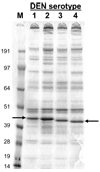Development of a recombinant tetravalent dengue virus vaccine: immunogenicity and efficacy studies in mice and monkeys
- PMID: 20097152
- PMCID: PMC2837772
- DOI: 10.1016/j.vaccine.2010.01.022
Development of a recombinant tetravalent dengue virus vaccine: immunogenicity and efficacy studies in mice and monkeys
Abstract
Truncated recombinant dengue virus envelope protein subunits (80E) are efficiently expressed using the Drosophila Schneider-2 (S2) cell expression system. Binding of conformationally sensitive antibodies as well as X-ray crystal structural studies indicate that the recombinant 80E subunits are properly folded native-like proteins. Combining the 80E subunits from each of the four dengue serotypes with ISCOMATRIX adjuvant, an adjuvant selected from a set of adjuvants tested for maximal and long lasting immune responses, results in high titer virus neutralizing antibody responses. Immunization of mice with a mixture of all four 80E subunits and ISCOMATRIX adjuvant resulted in potent virus neutralizing antibody responses to each of the four serotypes. The responses to the components of the tetravalent mixture were equivalent to the responses to each of the subunits administered individually. In an effort to evaluate the potential protective efficacy of the Drosophila expressed 80E, the dengue serotype 2 (DEN2-80E) subunit was tested in both the mouse and monkey challenge models. In both models protection against viral challenge was achieved with low doses of antigen in the vaccine formulation. In non-human primates, low doses of the tetravalent formulation induced good virus neutralizing antibody titers to all four serotypes and protection against challenge with the two dengue virus serotypes tested. In contrast to previous reports, where subunit vaccine candidates have generally failed to induce potent, protective responses, native-like soluble 80E proteins expressed in the Drosophila S2 cells and administered with appropriate adjuvants are highly immunogenic and capable of eliciting protective responses in both mice and monkeys. These results support the development of a dengue virus tetravalent vaccine based on the four 80E subunits produced in the Drosophila S2 cell expression system.
Copyright 2010 Elsevier Ltd. All rights reserved.
Figures

Similar articles
-
Preclinical development of a dengue tetravalent recombinant subunit vaccine: Immunogenicity and protective efficacy in nonhuman primates.Vaccine. 2015 Aug 7;33(33):4105-16. doi: 10.1016/j.vaccine.2015.06.067. Epub 2015 Jul 3. Vaccine. 2015. PMID: 26144900
-
Preclinical and clinical development of a dengue recombinant subunit vaccine.Vaccine. 2015 Dec 10;33(50):7126-34. doi: 10.1016/j.vaccine.2015.09.101. Epub 2015 Oct 14. Vaccine. 2015. PMID: 26458804 Review.
-
The development of recombinant subunit envelope-based vaccines to protect against dengue virus induced disease.Vaccine. 2011 Sep 23;29(42):7267-75. doi: 10.1016/j.vaccine.2011.07.021. Epub 2011 Jul 21. Vaccine. 2011. PMID: 21777637 Free PMC article. Review.
-
Tetravalent recombinant dengue virus-like particles as potential vaccine candidates: immunological properties.BMC Microbiol. 2014 Dec 18;14:233. doi: 10.1186/s12866-014-0233-3. BMC Microbiol. 2014. PMID: 25520151 Free PMC article.
-
Evaluation in mice of the immunogenicity and protective efficacy of a tetravalent subunit vaccine candidate against dengue virus.Microbiol Immunol. 2014 Apr;58(4):219-26. doi: 10.1111/1348-0421.12140. Microbiol Immunol. 2014. PMID: 24689365
Cited by
-
Dengue research opportunities in the Americas.J Infect Dis. 2012 Oct 1;206(7):1121-7. doi: 10.1093/infdis/jis351. Epub 2012 Jul 9. J Infect Dis. 2012. PMID: 22782946 Free PMC article. Review.
-
The necessity and quandaries of dengue vaccine development.J Infect Dis. 2011 Feb 1;203(3):299-303. doi: 10.1093/infdis/jiq060. J Infect Dis. 2011. PMID: 21208919 Free PMC article. No abstract available.
-
Pichia pastoris-expressed dengue 2 envelope forms virus-like particles without pre-membrane protein and induces high titer neutralizing antibodies.PLoS One. 2013 May 23;8(5):e64595. doi: 10.1371/journal.pone.0064595. Print 2013. PLoS One. 2013. PMID: 23717637 Free PMC article.
-
Recent progress in dengue vaccine development.Virol Sin. 2014 Dec;29(6):353-63. doi: 10.1007/s12250-014-3542-7. Epub 2014 Dec 24. Virol Sin. 2014. PMID: 25547681 Free PMC article. Review.
-
Precisely Molded Nanoparticle Displaying DENV-E Proteins Induces Robust Serotype-Specific Neutralizing Antibody Responses.PLoS Negl Trop Dis. 2016 Oct 20;10(10):e0005071. doi: 10.1371/journal.pntd.0005071. eCollection 2016 Oct. PLoS Negl Trop Dis. 2016. PMID: 27764114 Free PMC article.
References
-
- Halstead SB. Pathogenesis of Dengue: Challenges to Molecular Biology. Science. 1988;239:476–481. - PubMed
-
- Rigau-Perez JG, Clark GG, Gubler DJ, Reiter P, Sanders EJ, Vorndam AV. Dengue and dengue haemorrhagic fever. Lancet. 1998;352:971–977. - PubMed
-
- Gubler DJ. The global emergence/resurgence of arboviral diseases as public health problems. Arch. Med. Research. 2002;33:330–342. - PubMed
-
- Rigau-Perez JG, Gubler DJ, Vorndam AV, Clark GG. Dengue surveillance- United States, 1986–1992. MMWR. 1994;43:7–19. - PubMed
Publication types
MeSH terms
Substances
Grants and funding
LinkOut - more resources
Full Text Sources
Other Literature Sources
Medical

